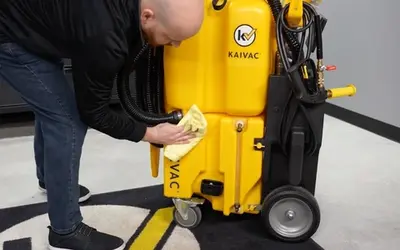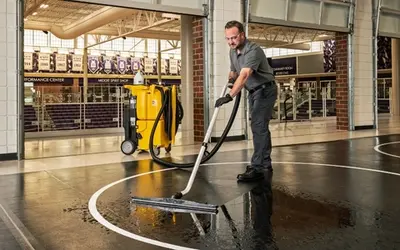Cleaning to Protect Athletes

Sport are back. But don’t expect these events to look like they used to. The new normal will include abbreviated seasons, strict guidelines around social distancing, and comprehensive protocols on cleaning to protect athletes.
COVID-19 and Sports: Weighing the Risks
While we are always learning new things about the disease, the science is pretty clear on how COVID-19 spreads. Droplets from an infected person are inhaled by or introduced into the mucus membranes of uninfected people. Certain situations, like crowding indoors with a lot of other people for an extended period of time, create more risk than staying outdoors with at least six feet of space between people.
Or, as epidemiologists like to say ‘time, space, people, place’.
It’s about ‘knowing the risk and accountability of the people you choose to be around, the amount of space available, and how much time you plan to spend with them,’ according to Lori Grooms, OSF HealthCare Infection and Prevention Control Director.
Given these factors, some activities present higher risks than others. Helpfully, the National Federation of State High School Associations along with the Sports Medicine Advisory Committee breaks out the risk as follows:
Categories of Risk in Sports
- Higher Risk: Firstly, the highest risk sports involve close, sustained contact between participants. The sport lacks significant protective barriers. There is a high probability that respiratory particles will be transmitted between participants. Examples include wresting, football, and competitive cheer.
- Moderate Risk: Next, moderate risk sports involve close, sustained contact, but with protective equipment in place that may reduce the likelihood of respiratory particle transmission between participants. Other moderate risk sports involve intermittent close contact like group sports or sports that use equipment that can’t be cleaned between participants like basketball, baseball, and gymnastics.
- Lower Risk: Lastly, the lowest risk sports that can be done with social distancing or individually with no sharing of equipment or the ability to clean the equipment between use by competitors. Examples include cross country running, individual swimming, and golf.
But no matter the sport, teammates should avoid activities like huddles, high fives, and hugs. And spitting? Fuhgeddaboudit!
Cleaning to Protect Athletes
Enhanced cleaning regimes will help protect athlete health. One school, Ohio State, values the cleaning so highly that EVERYONE in the Department of Athletics will be diligent and accountable for the cleanliness of the facilities, led by each facility’s operations staff.
The school exclusively uses EPA-registered ‘cleaner/disinfectants’. Staff will receive training on wearing, removing, handling, and storing personal protective equipment (PPE), and additional training on cleaning and disinfection practices.
They also pledge to:
- Establish dedicated times and protocols to sanitize and/or replace shared equipment;
- Clean and disinfect surfaces, desks, floors, podiums, doorknobs and light switches every 1-2 hours;
- Clean white boards daily;
- Provide staff with disinfectant wipes to clean their work areas, classrooms and computer stations before and after use;
- Vacuum carpeting nightly using vacuums with high efficiency particulate air (HEPA) filters;
- Clean hard flooring; and
- Thoroughly clean and sanitize the facility every evening.
Faster, More Thorough Cleaning
Organizations with big budgets can easily ramp up cleaning protocols by adding extra personnel and equipment—think professional and collegiate sports. But smaller organizations need the same level of cleaning to protect athletes. And even deep-pocketed groups want to be prudent with their resources.
Tools and technologies powered by vacuum removal help clean quickly and completely. For example, consider servicing weight rooms, locker rooms, rest rooms and shower rooms with a Kaivac No-Touch Cleaning System. Unlike mops and buckets, this spray-and-vac technology removes dirt, soils and bio pollutants. Pair it with an EPA-approved disinfectant like KaiBosh to clean and disinfect in one labor-saving step.
Staff or occupants should clean and disinfect shared equipment between each use. However, don’t just wad up a microfiber or cotton cloth for this task. Experts agree this could encourage cross contamination. Instead, fold cloths into eighths and use one section at a time. Technology like a SmartTowel with numbered panels makes this task easier.
SmartTowels quickly address touch points like doorknobs, light switches, and faucet taps.
Everyone is eager to restart sports, but no one wants to endanger health. Cleaning to protect athletes may let us get back to normal faster and that’s something to cheer about.
Related Posts

Preventive Maintenance for Your No-Touch Cleaning® System
Your Kaivac No-Touch Cleaning system makes restroom maintenance fast and easy. Keeping your No-Touch Cleaning system in good working order is also fast and easy. Kaivac makes performing preventative maintenance and troubleshooting potential issues simple. No special equipment or technical expertise required.
Read more
A Cleaning Lesson from Schools and Universities that Rely on Kaivac Systems
School, college, and university facilities departments from around the country love their Kaivac Cleaning Systems. Why wouldn’t they? Designed with the custodial worker in mind, these tools and processes from Kaivac are easy to master, work super-fast, and deliver exceptionally clean, fresh-smelling spaces.
Read more
Reduce Absenteeism Through Better School Cleaning
K-12 school leaders are coming up with a variety of ways to combat chronic absenteeism. Strategies like offering in-school laundry services and basic health care show a lot of promise. But providing better cleaning may be one of the most effective, most cost-efficient tactics available.
Read more